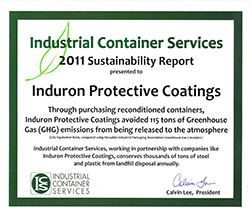By John Anspach, Induron VP of Operations
 I recently read an article in a coatings publication and came across the term “sustainability.” It’s quickly become a buzzword in industry – and even in personal – life. But just what does it mean?
I recently read an article in a coatings publication and came across the term “sustainability.” It’s quickly become a buzzword in industry – and even in personal – life. But just what does it mean?
One definition of sustainability, written about 25 years ago, is, “meeting the needs of the present generation without compromising the ability of future generations to meet their needs.” Today, it has been defined as, “providing the best for people and the environment, both now and in the indefinite future.
So how can a small business contribute to sustainability without drastically affecting how it does business? One way is to look closely at how you package your products.
For example, many of our products are packaged in metal drums. Years ago, Induron chose to utilize reconditioned drums instead of new ones for our packaging. The number of reconditioned, rather than new, drums we purchased last year resulted in 115 tons of greenhouse gas (CHG) emissions NOT being released to the atmosphere. That’s more significant than most might imagine – energy “avoidance” through re-use!
This simple example demonstrates that it may not require large sacrifices to your particular process or program to contribute to “sustainability.” Just think about your current process, recognizing opportunities that could incorporate the re-use of a raw material or package in that process. Go Green!
 In a flash of time, 15 years have passed. Unbelievable.
In a flash of time, 15 years have passed. Unbelievable.




 Recently, Induron was featured in CoatingsPro magazine’s
Recently, Induron was featured in CoatingsPro magazine’s  To ensure AquaClean’s performance matches its user-friendly and good-looking finish, many important design traits are formulated into the coating system.
To ensure AquaClean’s performance matches its user-friendly and good-looking finish, many important design traits are formulated into the coating system.




